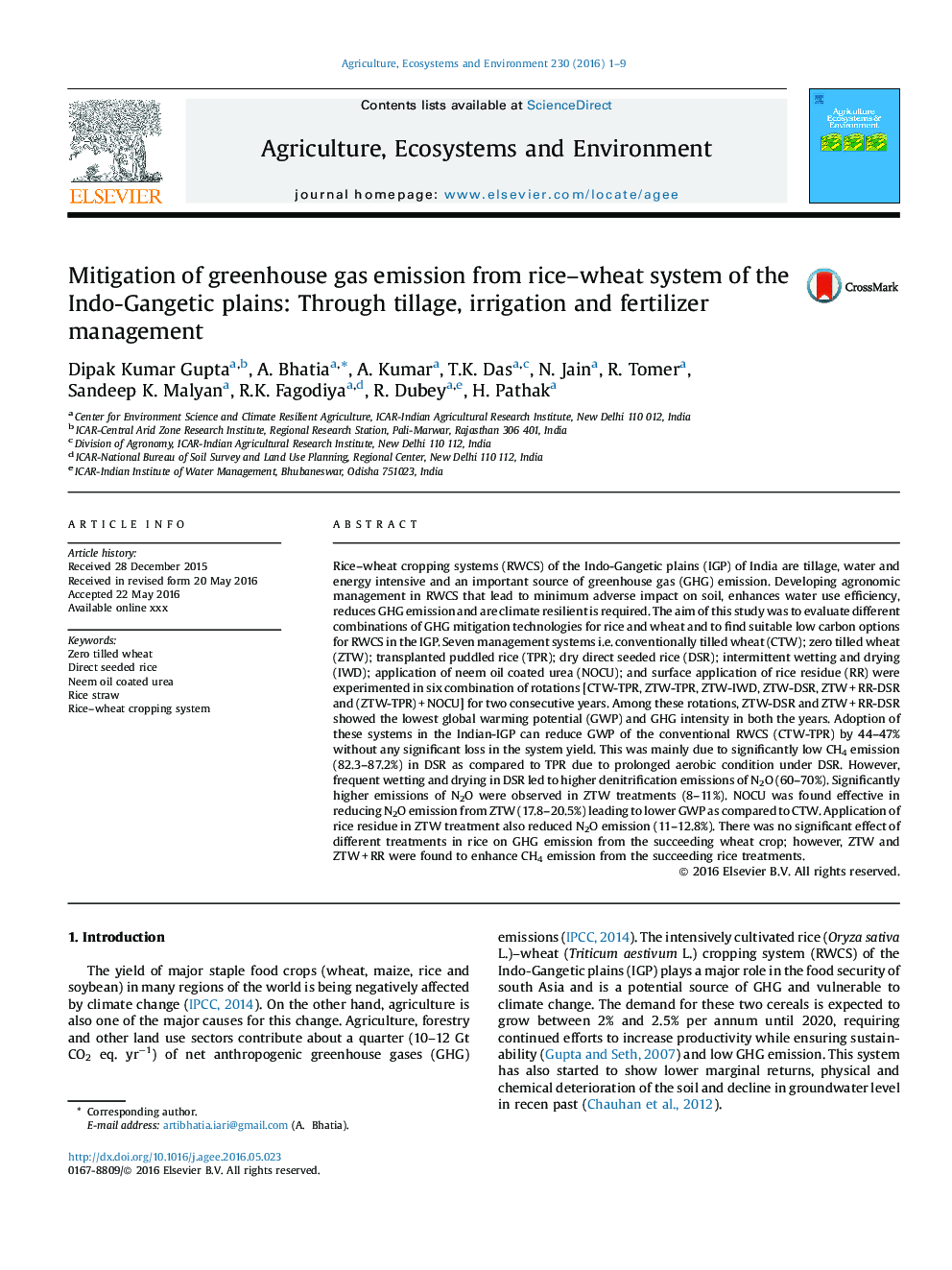| کد مقاله | کد نشریه | سال انتشار | مقاله انگلیسی | نسخه تمام متن |
|---|---|---|---|---|
| 8487370 | 1552022 | 2016 | 9 صفحه PDF | دانلود رایگان |
عنوان انگلیسی مقاله ISI
Mitigation of greenhouse gas emission from rice-wheat system of the Indo-Gangetic plains: Through tillage, irrigation and fertilizer management
دانلود مقاله + سفارش ترجمه
دانلود مقاله ISI انگلیسی
رایگان برای ایرانیان
کلمات کلیدی
موضوعات مرتبط
علوم زیستی و بیوفناوری
علوم کشاورزی و بیولوژیک
علوم زراعت و اصلاح نباتات
پیش نمایش صفحه اول مقاله

چکیده انگلیسی
Rice-wheat cropping systems (RWCS) of the Indo-Gangetic plains (IGP) of India are tillage, water and energy intensive and an important source of greenhouse gas (GHG) emission. Developing agronomic management in RWCS that lead to minimum adverse impact on soil, enhances water use efficiency, reduces GHG emission and are climate resilient is required. The aim of this study was to evaluate different combinations of GHG mitigation technologies for rice and wheat and to find suitable low carbon options for RWCS in the IGP. Seven management systems i.e. conventionally tilled wheat (CTW); zero tilled wheat (ZTW); transplanted puddled rice (TPR); dry direct seeded rice (DSR); intermittent wetting and drying (IWD); application of neem oil coated urea (NOCU); and surface application of rice residue (RR) were experimented in six combination of rotations [CTW-TPR, ZTW-TPR, ZTW-IWD, ZTW-DSR, ZTWÂ +Â RR-DSR and (ZTW-TPR)Â +Â NOCU] for two consecutive years. Among these rotations, ZTW-DSR and ZTWÂ +Â RR-DSR showed the lowest global warming potential (GWP) and GHG intensity in both the years. Adoption of these systems in the Indian-IGP can reduce GWP of the conventional RWCS (CTW-TPR) by 44-47% without any significant loss in the system yield. This was mainly due to significantly low CH4 emission (82.3-87.2%) in DSR as compared to TPR due to prolonged aerobic condition under DSR. However, frequent wetting and drying in DSR led to higher denitrification emissions of N2O (60-70%). Significantly higher emissions of N2O were observed in ZTW treatments (8-11%). NOCU was found effective in reducing N2O emission from ZTW (17.8-20.5%) leading to lower GWP as compared to CTW. Application of rice residue in ZTW treatment also reduced N2O emission (11-12.8%). There was no significant effect of different treatments in rice on GHG emission from the succeeding wheat crop; however, ZTW and ZTWÂ +Â RR were found to enhance CH4 emission from the succeeding rice treatments.
ناشر
Database: Elsevier - ScienceDirect (ساینس دایرکت)
Journal: Agriculture, Ecosystems & Environment - Volume 230, 16 August 2016, Pages 1-9
Journal: Agriculture, Ecosystems & Environment - Volume 230, 16 August 2016, Pages 1-9
نویسندگان
Dipak Kumar Gupta, A. Bhatia, A. Kumar, T.K. Das, N. Jain, R. Tomer, Sandeep K. Malyan, R.K. Fagodiya, R. Dubey, H. Pathak,